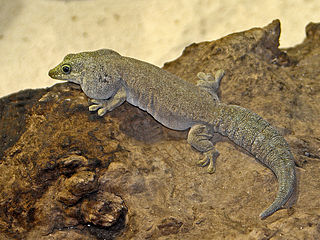
Phelsuma is a large genus of geckos in the family Gekkonidae. Species in the genus Phelsuma are commonly referred to as day geckos.

Barbour's day gecko is a species of lizard in the family Gekkonidae. The species is endemic to central Madagascar. It is diurnal and typically dwells on rocks. Barbour's day gecko feeds on insects and nectar.

The blue-tailed day gecko, also known commonly as Lacépède's gecko, is a diurnal species of gecko, a lizard in the family Gekkonidae. The species is endemic to the island Mauritius. It typically inhabits warm and humid places and dwells on different trees and bushes.

Phelsuma comorensis, commonly known as the Comoros day gecko, is a species of gecko endemic to the island of Grande Comore, Comoros. It typically dwells on trees, and feeds on insects and nectar.

Phelsuma dubia, also known as dull day gecko, olive day gecko, Zanzibar day gecko or green day gecko, is a diurnal species of gecko. It is about 15 centimetres (5.9 in) in length and lives on the western coast of Madagascar, in the Comoros, and the coast of East Africa. It typically inhabits trees and can also be found near human dwellings. The Dull day gecko feeds on insects and nectar.

The yellow-throated day gecko is an endangered diurnal species of gecko from eastern Madagascar. It typically inhabits rainforests and dwells on trees. This endangered species feeds on insects and nectar.

The Mauritius lowland forest day gecko, also known commonly as Guimbeau's day gecko and the orange-spotted day gecko, is a diurnal species of gecko, a lizard in the family Gekkonidae. The species is native to the western coast of Mauritius and typically inhabits large trees. The Mauritius lowland forest day gecko feeds on insects and nectar.
Mauritius upland forest day gecko is a diurnal species of geckos.

Reunion Island ornate day gecko or Manapany day gecko is a critically endangered diurnal species of gecko. It occurs only on the island of Réunion in the Indian Ocean, typically inhabits trees, and feeds on insects and nectar.

The gold dust day gecko is a diurnal species of gecko. It lives in northern Madagascar, the Comoro Islands, and the Mascarene Islands; it has also been introduced to Hawaii and other Pacific islands. It is primarily an arboreal species which can be found in tropical forests and may also associate with human dwellings. The gold dust day gecko feeds on insects and nectar.
Phelsuma laticauda angularisMertens, 1964 is a diurnal subspecies of geckos. It lives in northern Madagascar and typically inhabits different trees and houses. The Gold dust day gecko feeds on insects and nectar.

Standing's day gecko is an arboreal and diurnal species of lizard in the family Gekkonidae. The species is endemic to southwest Madagascar; it is threatened by illegal collection for the international pet trade and habitat loss. It is among the largest living species of day geckos. Standing's day gecko feeds on insects and nectar.

Pasteur's day gecko is a small diurnal subspecies of gecko. It lives in the Comoros and typically inhabits trees and bushes. Pasteur's day gecko feeds on insects and nectar.

Phelsuma v-nigra v-nigraBoettger, 1913 is a small diurnal subspecies of geckos. It lives in the Comoros and typically inhabits trees and bushes. Phelsuma v-nigra v-nigra feeds on insects and nectar.

Seychelles giant day gecko is a diurnal subspecies of geckos. It lives on the island Praslin in the Seychelles and typically inhabits trees and dwellings. The Seychelles giant day gecko feeds on insects and nectar.

Mahé day gecko is a diurnal subspecies of geckos. It lives on the western granite islands of the Seychelles and typically inhabits trees and human dwellings. The Seychelles giant day gecko feeds on insects and nectar.

Phelsuma pronki, also known as Pronk's day gecko, is a critically endangered diurnal species of gecko, a lizard in the family Gekkonidae. The species is endemic to central Madagascar, and threatened by severe habitat loss and collection for the international pet trade. It typically inhabits rainforests, dwells on trees, and feeds on insects and nectar.
Phelsuma pusilla hallmanni is a diurnal subspecies of gecko, a lizard in the family Gekkonidae. The subspecies is endemic to eastern Madagascar and typically inhabits different trees. This day gecko feeds on insects and nectar.

Phelsuma kely is a species of diurnal gecko. It is endemic to Madagascar and is known from the central east coast of Madagascar, south of Tamatave. It typically inhabits dragon trees. The gecko feeds on insects and probably nectar.

Ile aux Aigrettes is an islet off the south-east coast of Mauritius. It functions as a nature reserve and a scientific research station. It is also a popular visitors attraction — both for tourists and for Mauritians.























